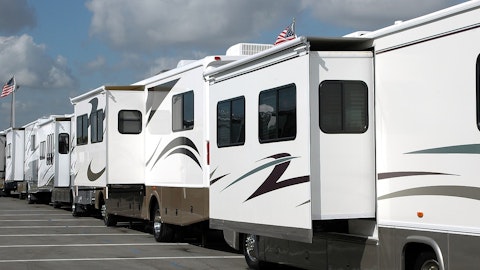Why we are happy overall, it’s first the product is well received, the product that we shipped in season ’23. We have introduced the dual engine Manitou that was very well received by the dealers at Club two weeks ago. The factory is now up and running and we are re-engaging the dealer and realigning all this for season ’24, then it’s a question about this. Obviously the factory in Mexico, we paused by one year. We’ve lost basically a season because of the industry and our–we were behind our plan, and this was just a logical move to do.
Fred Wightman: Makes sense, thank you.
Operator: Your next question comes from Cameron Doerksen from National Bank Financial. Please go ahead.
Cameron Doerksen: Yes, thanks. Good morning. Just trying to get maybe a little bit of a better handle on what you’re seeing in the retail. Obviously it’s still very strong for you, but I was wondering if you could maybe talk about how retail performed through the quarter, was it fairly steady throughout, and then what you have seen so far, I guess, in August? Obviously you’re facing a much tougher comp in your fiscal Q3, but maybe you can just talk about retail trends so far in the third quarter.
José Boisjoli: The retail, if we look at the year, retail was soft in February-March but picked up very good in April and continued the whole summer. I know that some of you were concerned about the model year ’22 three-wheel and watercraft, but we’ve been able to sell most of them and we’re very happy the way the season unfolded. For the third quarter, what is our expectation, I don’t want to go into too much detail and get into the habit of providing guidance every quarter for what’s coming, but overall we are in a good position for the second half because on the off-road, we have the new Maverick R, we have the additional Defender entry level product, the additional entry level product on the X3, and when I say entry level product in the side-by-side category, which is high end, we have the ATV mid-cc platform that is extremely well received, and the snowmobile line-up, as we’ve said, about half of our production is already pre-sold and we feel very good about off-road and snowmobile.
Obviously you can expect in H2 lower retail for watercraft and three-wheel because last year, we shipped the ’22 in Q3. When we look at the overall, we are planning the industry to be flattish, and us when you consider all the product lines, some reduction on watercraft and three-wheel and an increase in off-road and snow, we’re targeting to be around mid single digit growth for H2.
Cameron Doerksen: Okay, that’s very helpful. Just secondly, maybe switching gears, just want to talk a little bit about the EV roll-out. I guess at the Club, you kind of described that the final product that you’re going to introduce on the electric side is going to maybe be delayed by about a year, and there’s been some, I guess, challenges in developing the technology. Can you maybe just talk about what the challenges are that you’re facing there, and just how the EV roll-out and end development is going?
José Boisjoli: Yes, but first Cameron, I would like to remind you that we’re developing our own technology and we’re developing our own battery pack, motor, inverter, charger, software, and we believe by doing this all by ourselves, we will be better integration and performance than buying components that you need to put together, and it will be more cost effective. Doing this, it’s about people and suppliers, working with suppliers. This is going on. There is overall some delay, but it’s not–we had planned for some delays in some areas, but–and I just want to remind you that last year when we disclosed Rise and the two-wheel motorcycle, we said to the dealer that the product would be available in 2024, and some dealers, because we had some prospect dealers mainly from Europe in Atlanta, wanted to see with BRP what are the rest of the line-up, and we wanted to be very clear with the dealers.
We could have decided to show the specs, the prices, the allocation, and our plan for network fulfillment, but we felt it was too much information against the competition. We said very clearly, all the details will be unveiled next summer, and delivery for both the Rise and the two-wheel will happen in the fall of 2024. We’re not delaying by one year. You could debate some were expecting to have it earlier in the summer, but we are very basically overall on plan.
Cameron Doerksen: Okay, that’s helpful. Thanks very much.
José Boisjoli: Thank you.
Operator: Your next question comes from Craig Kennison from Baird. Please go ahead.
Craig Kennison: Hey, good morning, and thank you for taking my questions. It’s been a good call. I wanted to ask on the credit side, do you have an understanding or a read on the percentage of your buyers that are exposed to student loan repayments in the U.S.?
Sébastien Martel: I know it’s been on the news feeds recently, changes to student loans, but no, we don’t have that visibility, Craig, what percentage have outstanding loans.
Craig Kennison: Okay, and then maybe just said more broadly, I’m wondering if there’s a way to measure affordability in terms of monthly payments, if you look at a similar unit this year versus maybe pre-pandemic, how much more expensive is it per month relative to the income of your consumer, and do you see that consumer getting pinched in the climate we have today?
José Boisjoli: Yes, good morning. I will give you an example of the Sea-Doo Switch, because we were expecting the question, and obviously for ourselves to better understand the dynamic. But many of the buyers buy boats financed 15 to 20 years, and if you take a Sea-Doo Switch, and we took a model Switch Sport 21-seat, if you were financing–and again, the rate could vary depending on your score, but high level, if you were financing a Sea-Doo Switch in June ’22, your rate was 7%. If you were financing your Switch in June ’23, this year, your rate was 8.8%, and in August your rate was close to 12%. The difference between, let’s say June ’22, it was around $250, and it was $100 more in August ’23. Now, you can debate, $100 for someone who really wants the product, some will justify it, but when you commit for 15 or 20 years, it’s a long payment, and I think the rate increased so much in the last 12 months that some customers are reflecting if they will buy or not, and that’s why–that’s what affected, I believe, the boat industry.
Craig Kennison: That’s a really helpful example. Thank you.
Operator: Your next question comes from Martin Landry from Stifel. Please go ahead.
Martin Landry: Hi, good morning guys. Maybe just a follow-up to that. The power sports industry has been very resilient when you compare to the boating industry, and also when you compare to the RV industry. Is that resilience just related to price points, is that it? Is that the main explanation why the power sports industry is not seeing much sign of weakness versus other industries?
José Boisjoli: Well, the big difference between power sports and marine is in power sports, typically the people who finance will be three to five years, then your commitment is shorter. The other thing is the OEMs are–it’s easier for the OEMs to subsidize or to do a sales program to support the customers. I give you an example for us. Today we have, depending on the product line, for model year ’23 we have some offers that vary from 2% to 4% for 36 to 60 months, and this is very different than the example I gave into the marine business, both where obviously the rate is higher, the period is higher, and it’s more difficult for the OEM to justify the subsidizing. I think this is a big difference between the two industries.
Sébastien Martel: And Martin, if I could add one extra element there, if we look at what has happened to MSRPs in the last, call it the last four years since the onset of COVID, we saw much higher increases in MSRP in the marine and the RV sector than we’ve seen in the power sports sector. I’ll just give you an example. If I look at personal watercraft, model year ’20 to model year ’24, we’ve increased pricing by 17.4% in the U.S., whereas the boating industry has increased pricing by over 40%, and so that obviously makes the ticket item much higher for marine than for power sports. I think that’s one factor that’s also helping the power sports industry.
Martin Landry: Okay, that’s good color. That’s helpful. Maybe on [indiscernible] your guidance, your back half guidance implies strong EBITDA margins, I think higher than 18% according to our math. Sébastien, you touched in your opening remarks, heading into fiscal ’25 with strong momentum. Just trying to understand those strong margins in the back half, is there a seasonal tailwind here or can these higher margins be sustainable long term?




